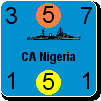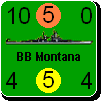composer99
Posts: 2923
Joined: 6/6/2005
From: Ottawa, Canada
Status: offline

|
I'm going to post a few distilled thoughts on CW convoy production and defences for the AI as I do not think we have gone into detail on this subject yet.
Building Convoys
The CW should pursue an aggressive convoy-building plan. If the CW plays a strong convoy defence, then it might be able to get away with not building many cps, just bludging off the free ones it gets for minor DoWs and the US, but it won't be able to do much else other than ship resources to the UK.
I would suggest the following buld plan:
39 - build 2 cps per turn
40 - build 3 cps per turn
41 - build 4 cps per turn
42 - build 5 cps per turn
43 - same as 42
Adjust to taste and strategic requirements, but be warned - going lower than these recommended levels may make things difficult in the late game, as we shall soon see.
Why Build so Many Convoys?
Don't we want pointy bits, too? Of course. But what are these convoys for?
(1) Replacing losses worldwide.
(2) Enabling the CW to ship lent resources & build points to France/Free France, the USSR, and China.
(3) Enabling the CW to receive lent resources & build points from the US and (occasionally) France/Free France.
(4) Ship, without substantial interruption, resources to the UK for production and oil where needed worldwide for saving.
(5) Have the reserves to be able to keep throwing out convoys for supply in places like the Med, North Sea, or South China Sea (if playing with Limited Overseas Supply).
Edit:
When to Stop
Chances are, if the CW and US have put an end to the German submarine threat, the CW can stop building convoys, as early as late '42 if they've done a real good job. It should be safe to do so when the following requirements are met:
(1) There are enough convoys world-wide to meet all the Allies' resource shipping and resource/build point lending requirements for the rest of the game.
(2) The Axis submarine threat is largely curtailed in the Atlantic and Murmansk run; and Axis fleet threats are curtailed in any theatre where CW convoys are running (esp. the Indian Ocean and Med).
(3) There is a reserve of convoys (between 1/2 to 1 dozen cp apiece) in each theatre to cover potential losses in the final stages of the war.
End of Edit
A Note on Lend-Lease
In order to keep the Allied economies humming at maximum, especially in 43-44, the Western Allies won't just be passing around some lend-lease. They will want to be passing around a huge freaking pile of lend-lease (resources & build points). I would estimate that from 42 on the USSR should be getting 5-10 bps and extra resources on top of that per turn; that from 43 on the CW should be getting 5-10 bps per turn; and from 42 on Free France should be getting 2-4 build points per turn. Add in resources & bps to China, too. Once France is liberated they will have room for extra resources and build points, and should certainly get some. By mid to late 44 the lending to USSR can probably slack off, so the French can pick up the slack.
This is to say nothing of the resources & bp the USSR should be getting from the moment it's at war with Germany (if not earlier if you pass Resources to USSR before Barb), and the resources the CW may need lent from the US during the dark days of 40-41.
So, how many convoys will all this lending require, especially in 43-44? Loads of them. And you don't want to be hobbled by shortages. So build a lot and defend them strongly.
Defending Convoys
There are four major "zones" of convoys: the "primary pipeline", that lifeline from US East Coast through the North Atlantic to either Bay of Biscay or Faeroes' Gap; the "southern lines", in the Caribbean, Mouths of the Amazon, Cape St. Vincent, Cape Verde Basin, Gulf of Guinea and Cape Basin; the "Murmansk run", the northern lend-lease route to the USSR; and the "Asia-Pacific" region, consisting of every sea area you're putting convoys through in the Asia-Pacific map, including (if needed) supply convoys in the Red Sea.
Each region has its own convoy defence requirements, which will vary depending on whether or not you are using SiF, SiF/CLiF, SiF/CoiF, or SiF/CLiF/CoiF.
Food in Flames: If you are playing with Cruisers in Flames (CLiF) and Convoys in Flames (CoiF), I would recommend that you play with Food in Flames (or allow the AIO to do the same). The CW alone will be on the hook for large-scale extra production requirements for light cruisers and ASW units, so it seems fair to give them some extra tools
to do the job.
The Primary Pipeline
The main pipeline is where the vast majority of your convoy capacity will sail through (and likely as not be sunk in). As such, it needs the staunchest defences.
SiF Only
Each of the sea areas in this region needs 2 cruisers (CAs) in the 4, 1, and 0 boxes. Consider using slow minor country CAs to provide extra oomph in the lower boxes. Each sea area also needs a NAV, preferably one with 3-4 factors, to intercept into the sea area during eligible naval combats. Do not EVER let these NAVs get committed to anything else. Any sea area that cannot get a NAV (usually the N. Atlantic before Azores are secured) must have instead CV/CVLs in the 1 and 0 boxes.
Once the US has passed the appropriate options, it should pump defences into as many sea areas as it is allowed to cover, including NAVs. Once it is in the war, it should boost your defences across the entire region, as well as taking over responsibility for at least one of the sea areas, freeing up your forces to defend other regions.
Long-Range NAVs: Consider building the 4-point NAVs (Sunderlands) to fly to the 4-boxes of the main pipeline. They will act as a good deterrent vs. the subs, and give you a 50% chance of finding and taking free potshots at the subs without threat of retaliation. You could instead use the 3-point NAVs, but I think they are better suited for offensive operations (naval air missions in the Med or port attacks in Europe or the Med).
As convoys become available from minor alignments or production, consider routing the resources from India/Africa and the Mouths of the Amazon through the main pipeline instead of up Cape St. Vincent. This concentration may seem like putting too many eggs in one basket, but more cps equals more ASW factors, and you then don't really need to defend Cape St. Vincent much, especially if you are not playing with limited overseas supply, aside from a CA or two in the 4 box.
CLiF
When playing with CLiF, substitute light cuisers (CLs) for CAs; if you have the spares have three CLs in the 4,1,0 boxes of each sea area of the main pipeline. For extra surface/ASW oomph, consider keeping one CA per box as well. Everything else, tactics wise, is pretty well identical to just SiF.
CoiF
You start with one ASW unit. Build more, aggressively. Consider bulding ahead, especially to get those precious, precious ASW CVs.
When playing with CoiF, you no longer get the ASW factors for convoy points, so the ASW units are absolutely necessary. You will probably want 3 factors of ASW units for every 5 convoys in the main pipeline, and an ASW CV in each sea area as well (2 ASW CVs in sea areas where you can't get NAVs).
Do not give up on using the NAVs just because you have ASW CVs, though. The good news is that once you have built and deployed the ASW CVs, you can send any CVs or CVLs doing escort duty in the main pipeline elsewhere, either for fleet actions (as part of the operational or reserve fleets) or for convoy escort elsewhere (especially the Murmansk run).
If you are aggressively building ASW units, the US will not need to build many. It should still build a few for use in the main pipeline with the goal of taking over the total defence of one or more sea areas in the pipeline so you can send the freed-up ASW units to other convoy routes, enhancing Allied shipping security (and hence the Allied economies) world-wide.
And now I have to go to work, so I will post more during lunch break and when I get home.
< Message edited by composer99 -- 9/6/2007 7:46:15 PM >
_____________________________
~ Composer99
|
 Printable Version
Printable Version







 )
) 


 ) and 1 ASW unit. On the other hand I begun the strategic offensive against Germany, and have landed in Italy (next session we'll see if I'm repelled or not). So I'm stuck with defending my convoy lines with Cruisers and some BB in reaction where the Kriegsmarine could come.
) and 1 ASW unit. On the other hand I begun the strategic offensive against Germany, and have landed in Italy (next session we'll see if I'm repelled or not). So I'm stuck with defending my convoy lines with Cruisers and some BB in reaction where the Kriegsmarine could come. 


 New Messages
New Messages No New Messages
No New Messages Hot Topic w/ New Messages
Hot Topic w/ New Messages Hot Topic w/o New Messages
Hot Topic w/o New Messages Locked w/ New Messages
Locked w/ New Messages Locked w/o New Messages
Locked w/o New Messages Post New Thread
Post New Thread